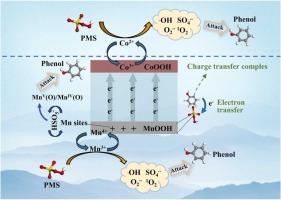Enhanced Peroxymonosulfate Activation by MnOOH/CoOOH Composites for Efficient Phenol Degradation: Mechanistic Insights and Practical Implications
IF 5.8
2区 材料科学
Q2 CHEMISTRY, PHYSICAL
引用次数: 0
Abstract
The strong electronic interactions between metal oxide components are crucial for the activation of peroxymonosulfate (PMS) in pollutant degradation. In this study, an innovative MnOOH/CoOOH composite material (labeled as B-MCo-0.1) was synthesized through mesoscale chemical coupling, serving as an efficient PMS activator for phenol degradation. Experimental findings suggest that CoOOH nanosheets incorporated on MnOOH surface prevent CoOOH aggregation, increase specific surface area, and enhance the synergistic interaction between components, thereby improving activation and degradation efficiency. Under optimal conditions, a 50 mL phenol solution (25 mg/L) can achieve 100% degradation within 10 minutes. XPS analysis reveals that the robust electronic interaction between CoOOH and MnOOH facilitates PMS activation, generating reactive oxygen species (ROS) that effectively degrade phenol through both non-radical and radical pathways. Experiments, including quenching tests, electrochemical analysis, electron paramagnetic resonance (EPR) measurements, and sulfoxide method experiments for identifying high-valent metal oxides confirm that singlet oxygen (1O2) and superoxide anion (·O2−) play major roles in this process. Additionally, high-valent manganese oxides and electron transfer complexes on the catalyst surface, generated under strong electronic interactions, also contribute significantly to phenol degradation. By exploring the pivotal role of robust electronic interactions in activating PMS, this study extends the potential applications of MnOOH-based materials in environmental remediation.

MnOOH/CoOOH 复合物增强过一硫酸盐活化以高效降解苯酚:机理认识和实际意义
金属氧化物成分之间强烈的电子相互作用对过氧化单硫酸盐(PMS)在污染物降解过程中的活化至关重要。本研究通过中尺度化学耦合合成了一种创新的 MnOOH/CoOOH 复合材料(标记为 B-MCo-0.1),作为一种高效的 PMS 活性剂用于苯酚降解。实验结果表明,在 MnOOH 表面加入 CoOOH 纳米片可以防止 CoOOH 的聚集,增加比表面积,增强各组分之间的协同作用,从而提高活化和降解效率。在最佳条件下,50 毫升苯酚溶液(25 毫克/升)可在 10 分钟内实现 100% 降解。XPS 分析表明,CoOOOH 和 MnOOH 之间强大的电子相互作用促进了 PMS 的活化,产生的活性氧(ROS)可通过非自由基和自由基途径有效降解苯酚。包括淬灭试验、电化学分析、电子顺磁共振 (EPR) 测量和氧化亚砜法实验在内的用于识别高价金属氧化物的实验证实,单线态氧 (1O2) 和超氧阴离子 (-O2-) 在这一过程中发挥了重要作用。此外,催化剂表面在强电子相互作用下产生的高价锰氧化物和电子转移复合物也对苯酚降解起了重要作用。通过探索强电子相互作用在激活 PMS 中的关键作用,本研究拓展了基于 MnOOH 的材料在环境修复中的潜在应用。
本文章由计算机程序翻译,如有差异,请以英文原文为准。
求助全文
约1分钟内获得全文
求助全文
来源期刊

Journal of Alloys and Compounds
工程技术-材料科学:综合
CiteScore
11.10
自引率
14.50%
发文量
5146
审稿时长
67 days
期刊介绍:
The Journal of Alloys and Compounds is intended to serve as an international medium for the publication of work on solid materials comprising compounds as well as alloys. Its great strength lies in the diversity of discipline which it encompasses, drawing together results from materials science, solid-state chemistry and physics.
 求助内容:
求助内容: 应助结果提醒方式:
应助结果提醒方式:


